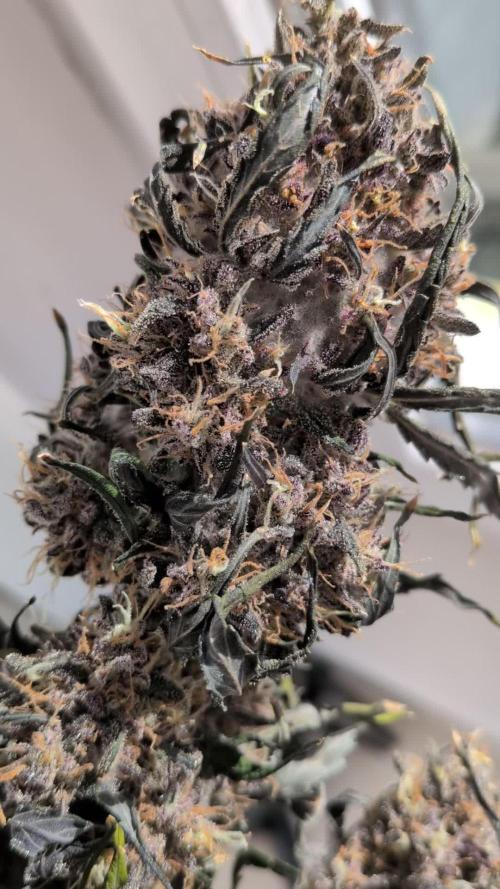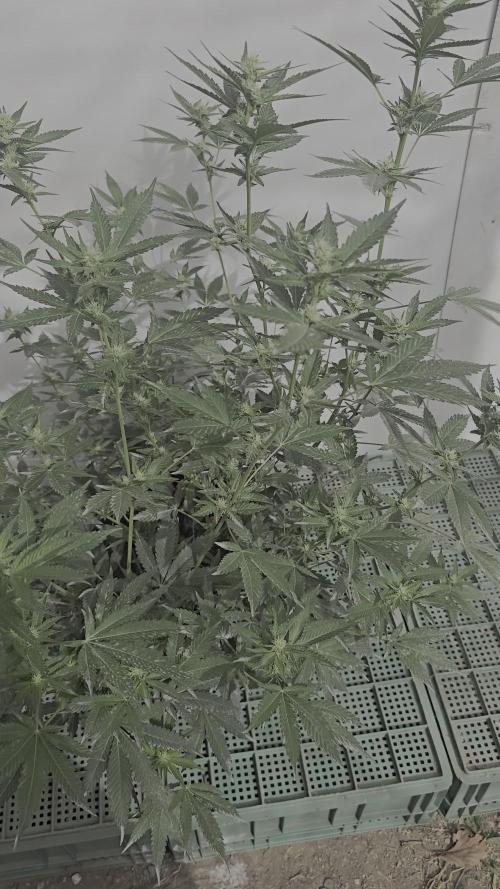The Grow Awards 2026 🏆 

































Likes
Comments
Share


@ToastFarmer
Follow
No deficiencies thus far adding some molasses each feeding 1 tbls per gal water
Likes
89
Share


@Gunnen
Follow
It's now over the end of week 13. These pictures are about 2 days past a week. So I will upload next step in about 5 days. Things are smelling great and nugs are getting dense. Colors are coming in purples on the fade, looks nice. Trichomes are milky on most but still some clear, not much amber. Will be waiting likely another week or 2 even to see what happens. So far these have been champs, honestly been a pleasure to work with. Though I think the plants might not agree! Even with the mishaps we got some good bud going and some great crystal coverage. Excited to see the drying and product. Cheers everyone, happy growing.
Likes
35
Share


@bioaccessory
Follow
Hello colleagues!
As for an autoflower, the cycle did not take much time and brought good results for me. Thanks to GanjaFarmerSeeds for the opportunity to test a new strain, also thanks to everyone who came and commented on this diary 🙏
See you soon😀👍
Likes
11
Share


@TiRobotProds
Follow
Bud grossis bien odeur de fruits rouges dégage de cette magnifique spécimen.
Likes
19
Share


@Sti_Cazz
Follow
The switch from last week to this week, veg into bloom, has gone super fast!
I've done 2 waterings this week, 1st with just water and second I added bio bizz bloom 1 ml/l, root booster and cal mag. All at 1ml/l and this time i took the time to check ph and ppm.
I had to lower pH (scary) for the second time from 7.1 to 6.1 and I'm seeing definate effect in the amount of white pistil growth! So much more vigorous the last grow, when I overfed.
Likes
34
Share


@marihoochi
Follow
I am convinced that I've managed to avoid a nitrogen toxicity by monitoring the inputs and the runoff of individual pots. There is only 1 plant remaining whose runoff was 300 above inputs and was showing the curled, too-dark leaves . The plants look happy, yesterday I played some rocking Mozart for them and they loved it!
Today Oct 12 (Canadian Thanksgiving almost) is 2nd Day of Week 4 In Bloom and 87Days Old. I defoliated yesterday quite a bit; I've read that this is a no no as it takes energy to repair but I did it anyway, the plants reacted like they appreciated the haircut😶 I'll never know how it affected the buds. The buds are no longer hiding under the foliage as much👍 Took some of these pictures and video with only 1 light on - to try and show their "true" colour.
Inputs Temp 20, PH 6.3, EC 1.8
Runoffs 1 Pot 2.1EC, 6 Pots 2.0EC, 4 Pots 1.9EC, 4 Pots 1.8 EC, 1 Pot 1.7EC
Oct 16 - 32 Days In Bloom 91 Days -- Fed Again-Inputs: Temp 20, EC 1.8 PH 6.3
Run off: Temp 20, PH 6.3 EC 1.8, 1.9, 2.0 on all pots😊 First time using Enzymes; see if I notice anything. Smell has definitely increased in the last couple of days.😁
I am stoked on how these budlets have developed, the ladies are forming almost textbook style and right on time! (finally from providing proper nutrition and environment). Rails of goodness are starting. This has been the best indoor grow to date .
Likes
16
Share


@bsplayerone
Follow
Week 2 started off rough as the hot sun and lack of water caused her to fall over. I watered her last night and she’s back up today. Another week of just sun and water. It’s a rainy week so got some humidity in the air
Likes
11
Share


@GelatoGandalf
Follow
Well, this harvest didn’t go perfectly — my main cola got hit with bud rot, and I had to toss about 80% of the plant. Kind of glad I went with a perpetual harvest this time. Not sure if the rot started inside the tent or if I just didn’t pay enough attention during drying.
Anyway, what’s left is honestly the best weed I’ve ever grown — maybe even the best I’ve ever had. Not because it’s the strongest, but because of the insane terps and the incredibly pleasant effect.
The terps stayed exactly the same as they were in late flower: full-on lime pie and funk. I love it. Absolutely no mango in there, but who cares — if you’re into terps, this one is a benchmark for me.
The effect is best described as a true hybrid: uplifting and creative, but with a relaxed, calm body high. No headache, no anxiety, no couchlock — just a perfect balance. I’m completely in love. This is solid proof that genetics are the single most important factor in a grow. Well done, Mephisto.
Also, this stuff stinks! Absolute epitome of “loud.” I literally have to burp my jars with the window open because of how strong it is.
Likes
147
Share


@Coco4CocoPuffs
Follow
😴💤😴💤😴💤😴💤😴💤😴💤😴💤😴💤😴
We are now at day 84 from seed and we are 53 days in flower 👈 I am running 2 Sleepys and both are doing great 👍
so new nutrients plan has once again started 🙂by switching to just fresh water 🤔 let's go Brandon 👈😄😅😆
we are just steaming ahead everythings is fire 👍
Thank you my friend for the support 🙏
😴💤😴💤😴💤😴💤😴💤😴💤😴💤😴💤😴
@premium_cultivars
Likes
149
Share


@CBD_Sweden
Follow
Hi all the happy people here in GrowDiaries.
This is my second cultivation ever and it will be fun to try a bigger space than my closet grow.
First, I'm just going to say I'm done with the construction of my new growroom.
I put some pictures on the construction here in week one.
The room is 2.14 meters by 1.7 meters and has a ceiling height of 2 meters.
It provides a floor area of 3.6 square meters.
I use a 54 Watt Lightwawe T5 for germination and 2 Pcs 400 Watt HPS lamps.
I have a channel fan that replaces the room air about 40 times an hour to get a comfortable theme in the room, the air enters a fresh air intake from the outside.
The air is purified through a carbon filter to then leave the room to the rest of the basement.
Then I use that heat to heat the rest of the basement.
I will use 8 pcs 15 liter Autopots to grow with and a 100 liter water tank that supplies the pots of water and nutrition.
I will grow completely organically in soil and will watercure my buds to get the best possible medicine for me.
But there are no cultivation rooms to be displayed here, so I continue with what is most important.
Today I have put my seeds in my moisture dome and hope the seeds have germinated within a few days.
I am very excited to see how the new growroom will work and how this Blue cheese Auto from Royal queen seeds will turn out.
Blue Cheese automatic cannabis seeds are a cross of Blueberry Automatic and Cheese Automatic that has been perfected over five years of breeding and careful selection. The result is a feminized, autoflowering strain with superior yield, flavor, and effects to either of its distinguished parent strains.
THC: 16%
CBD: Low
Yield Indoor : 325 - 375 gr/m2
Yield Outdoor: 60 - 110 gr/plant
Height Indoor: 40 - 70 cm
Height Outdoor: 60 - 110 cm
Flowering: 7 - 8 weeks
Harvest month: 9-10 weeks after planting
Genetic Background: Blueberry x Cheese x Ruderalis
Type: Sa 35% In 40% Ru 25%
Effect: Cerebral and uplifting
Climate: Mild
..............................................................................................................................................................................................................................................................................................................................................
2017-09-11. Kl 12.00. Week 4 starts. I have cleaned the whole room for the new week and gave the girls water and nutes. Added videos and pics. Girl nr 1 is 27 cm high and girl nr 2 is 50 cm high and nr 3 is 15 cm high.
-------------------------------------------------------------------------------
2017-09-12. Kl 10.00. New pics and video. Nr 2 has grown 5 cm in 23 h, its incredible.
---------------------------------------------------------------------------------------------
2017-09-13. Kl 22.00. Everything is great in the garden right now. Updated with new video.
----------------------------------------------------------------------------------------------------------------------------
2017-09-15. KL 10.00. New pics and videos. Girl Nr 1 is 33 cm high, Nr2 is 70 cm and girl Nr is 22 cm. Nr 2 has grown 20 cm the last 3 days. Look at the stem of girl Nr 2 😍
The girls are starting to smell a lot now. Its a intense smell in the grow room.
-----------------------------------------------------------------------------------------------------------------------------------------
2017-09-16. Kl 10.00. The girls grow like crazy, i have to defoliate about 20 leafs a day. Nr 2 is 76 cm tall now, i wonder when she slows down?. Added 2 liters of water and nutes this morning and 2 new videos.
------------------------------------------------------------------------------------------------------------------------------------------------------------------
2017-09-17. Made a time laps of the girls first 28 days.
Likes
1
Share


@Ti_BR
Follow
This is the day 21 of flowering. I Will defoliate the plants today. This is my First diary, so i dont have pics of veg stage. The OGs and Gorillas ghosts are Very different. The OGs Veg feed was 0.8 EC on first weeks, then 1.0. Now on flowering they feed 1.1. Very low. The gorillas liked 1.3 EC on Veg and now they are feeding 2.0/2.2. I aways mensure de entrance feed and the runoff of each one. I expent almost 90 days on Veg becouse the GG delay a little at the beginning. My mistakes, a little overwatering and low feed. I underfeed the plants on First week of flowering to finish the nitrogen on substrate, so the bigest GG show calcium Def signs (you can see on imagens). But now is solved, they are health green again. Soon i Will post New pics.
Likes
9
Share


@JoeyGonz
Follow
They popped up pretty quick.. Got new tent for them. Waiting on light mover to put them in there permanently. Hopefully it gets here tomorrow night. But this set up it’s the cats ass.. Tent is solid and very very nice in quality I highly recommend it. Got the Infinity auto control fan too make this easier. Waiting on charcoal filters so I can cut them and attach them to the bottom intakes somehow. That’s my only complaint they give you nice large intakes just no way to block the light if open. But I figured something out I’ll show you later.. I also ordered a separate plastic floor pan that actually fits perfectly it’s like 23.5”x 47”.. Tent comes with nice fabric pan just don’t wanna ruin it..
Likes
2
Share


@902EastCoast
Follow
Easy to grow, beautiful structure and plant. Big frosted, dense buds with very good odour 🤤. Would 100% recommend.
Likes
10
Share


@BelgianBudtender
Follow
Hey growmies!
what a week for this plant, she responded wonderfully to the lollipopping and defoliation performed last week, in fact she started voraciously eating and i had to keep increasing dose and water every day. She did enter flower now, I have taken off a few more offshoots that wouldn't have yielded much bud and was crowding the canopy with tiny branches. Now was my last chance to take off said shoots, because this girl has started pumping energy into stretching, and now more of that precious energy will go into more dominant branches, that ultimately will yield higher quality flower.
Could I technically have higher yield if I left the little branches? possibly. but that weight would come in fluffy bud that choke out airflow and nutrients away from the pretty flowers, which in turn suffer.
the plant started stretching and she grew too close to her new lights, as a result all my tops have yellow tips, she should recover nicely however, I have raised the lights back to 45 cm above the canopy.
Speaking of canopy, this autoflower is pretty big, atleast in DWC, so if you're growing her, deffo ScrOG her.
Hydroguard keeps my roots pretty healthy, even during the heatwave without a chiller!
next week i will put in a second trellis, help her while she stretches! hope to see you then
Likes
16
Share


@Boomdrawfyah
Follow
98 dias de vida, vamos aumentando la cantidad de terravigor y terrateina, y el
producto estrella de terranabis el
Terpesyn que hace que los cogollos brillen de la resina que sacan. Estan floreciendo muy fuerte se esperan grandes resultados, aunque esta semana se predicen tormentas vamos a aguantar con todo lo que venga
Likes
35
Share


@Papablob
Follow
je note une forte décoloration des feuille.. J'ai tranché pour un manque de nutriment.. On verras bien.
05/05/22 soir: Défoliation du bas. Bon.. C'est trop tard mais ca m'arrange pour arroser et observer. C'est étrange que même l'aspect de la terre en surface change a ce point.😮
Ca reverdi. Donc c'était bien un manque, plus certainement un coup de froid. On a eu une coupure d'électricité une nuit très froide.
Likes
4
Share


@Facocero
Follow
Siamo giunti alla 2° settimana di fioritura 🤩
Sto iniziando a notare l'allungamento delle piccole.. per ora ha solo dei piccoli pistilli, ma credo che a breve esploderanno🤤🤤






















